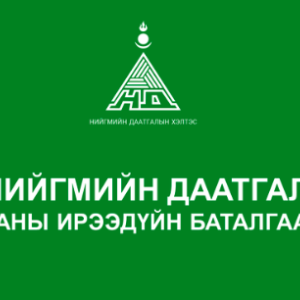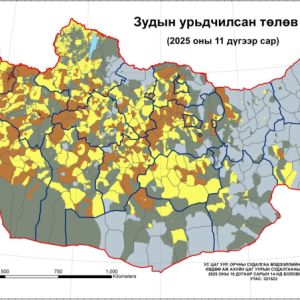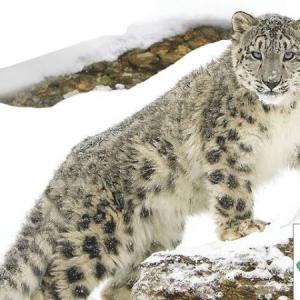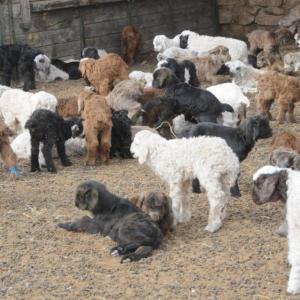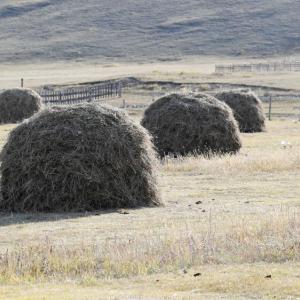Baby camel wool versus goat cashmere: Which is really better?
Economy
Mongolia, with over 65 million head of livestock freely grazing on natural rangelands, has much to offer to the world’s consumers when it comes to eco-friendly products of animal origin. Besides goat cashmere, Mongolia has the potential to offer other high quality natural fibres to the market, such as camel wool, yak down, and sheep wool.
As part of its goal to
support eco-friendly production, thereby ensuring sustainable rangeland
management and increasing the income of herder families, the Green Gold Project
of the Swiss Agency for Development and Cooperation in Mongolia has been working
to improve the value of yak down and camel wool over the last decade. Having
seen the potential to attract consumers in the international market, the project
started an initiative to develop products from baby camel wool. Compared to
goat cashmere, the content of coarse hair in de-haired (processed) baby camel
wool and yak down used to be 4-6%, while in goat cashmere it is 0.2%-0.3% or 20
times lower. One reason for this is that goat cashmere is collected by combing,
while camel and yak wool was typically collected by shearing. In order to
reduce coarse hair content, since 2014, Green Gold Project has been testing baby
camel wool combing in Gobi-Altai, Bayankhongor, Umnugobi, Dundgobi, Dornogobi,
Zavkhan and Uvs provinces. During these tests, it was realized that when combed,
the collected fibre’s diameter is 15.4-16.1 microns and the average length is
38.5-42 mm, which makes it equal to goat cashmere in terms of quality. The
project continues working with herder families in the Gobi region to deliver
this exotic fibre of the best quality to appeal to international buyers.
Cashmere, well known as
the most luxurious and best quality of luxury fibre, has been the main source
of cash income among herders for decades. As the public is now aware that baby
camel wool can be as fine as cashmere, there is hope among herders that the
value of baby camel wool will increase.
Getting rid of old
habits leads to new opportunities
Until recently, herders
have prepared camel wool by shearing their camels. Identifying this old habit
as the main reason behind the quality issue, the Green Gold Project has decided
to introduce combing as a new method for camel wool preparation. In
collaboration with researchers and herders, the project first tested this
initiative in 2014. The test results proved that combed camel wool has much
higher yields of quality fibre and lower hair content.
Camel wool consists of
three different fibres: down, coarse hair, and dead hair. The coarse hair from a
camel is 1.8-2 times longer than the down fibre. In this new technique, the
coarse hair is sheared first. After that, the down fibre is combed from the
rest of the wool. This technique helps to considerably reduce the hair content
in camel wool. While hair content makes up 0.3% in combed cashmere, it makes up
3% in sheared camel wool. However, this number can be reduced to 1% if camel
wool is prepared by combing.
In 2020, around 15 tons
of combed baby camel wool is prepared by PUG cooperatives at the national
level. The combed wool was supplied to domestic processors and, as a result,
soft and luxurious products were made that could compete, from a quality
perspective, with cashmere products.
We talked to Ts.
Shirnen, one of the best camel herders in the nation, regarding how herders
have adopted the new technique of combing baby camel wool. Ts. Shirnen, who is
known for having the largest number of camels in Bayankhongor Province, said:
“As I have herded camels for years, I have always been eager to improve
the quality of camel wool. Therefore, I have taken some measures to improve the
quality of my breed. There are three top camel breed on my farm, such as the “brown”
camels from Khanyn Khets, “red” camels from Galba Gobi, and “double-maned”
camels from Tukhum Tungalag. We also have another breed of camel, the origin of
which is not yet defined. The reason for putting more focus on the breeds is to
bring the quality of camel wool up to the quality of cashmere. Because baby
camel wool can be as fine as cashmere, herders have started preparing camel
wool more responsibly. My family combs around 200 baby camels every year. The
yield from each baby camel is approximately 1.5 kilos. We have used this
approach for camel wool preparation for two years. Combing baby camels can
actually be much more difficult compared to combing goats. Considering the
level of work involved in combing baby camels, we hope that the value of camel
wool will increase. In the future, if good quality fibre (of cashmere quality)
is collected not only from baby camels, but also from adult camels, herders
would slaughter less camels for their meat.”
Branding a one-year-old baby camel
According to a project
study conducted in 2014, one-year-old baby camel wool can be as fine as
cashmere. According to the results of this study, the diameter of fibre from
one-year-old baby camels was 16.3 microns and fibre from two-year-old baby
camels is between 17-18 microns. This shows that wool from one-year-old baby
camels can be competitive with cashmere, the diameter of which is around 16.5
microns.
In order to introduce
camel wool as a substitute for cashmere, thereby increasing the value of camel
wool, the project is encouraging herders to comb one-year-old baby camels.
Regarding the demand from domestic processors for baby camel wool, V. Bolormaa,
a textile specialist at the Ministry of Food, Agriculture and Light Industry,
said:
“If only one-year-old baby camels are combed, 50-60 tons could be
prepared at the national level. Of course, this is not a huge number when
compared to cashmere, which is around 8,000 tons annually at the national
level. This shows the rarity of this unique fibre from baby camels. Therefore,
this exotic fibre should be utilised for making only expensive and luxurious
products. It is crucial to prepare raw materials properly and make improvements
in primary processing. It is important not to mix camel wool with other types
of wool at the factory. It is also crucial not to make mistakes during the
scouring and de-hairing processes. The processors have to be careful at each
stage of processing baby camel wool. In order to increase the value of camel
wool, we need to put this exotic and luxurious fibre, which is specially
prepared through combing, into production and promote it in the international
market. We could increase the number of environmentally friendly camel herds by
adding value to their fibre”.
In general, the dyeing of camel wool is difficult because coarse hair does not take any colouring and the coarse hair content of camel wool is much higher compared to goat cashmere (goat cashmere 0.15-0.25%, camel wool 3.5-4.5%). As this makes the colour look tainted and unclean, domestic processing companies were not in favour of dyeing camel wool. However, combed baby camel wool contains only 0.2-0.5% of coarse hair, which should make dyeing possible.
With the successful
dyeing of baby camel wool, the Green Gold Project has provided manufacturers with
the opportunity to make garments that equal cashmere not only in softness but
also in range of colour. This offers the chance to establish a competitive and
more sustainable alternative to cashmere in the national and international
fashion and textile markets. This will greatly support the intended reduction in
the use of cashmere and, correspondingly, in the goat population at the national
level.
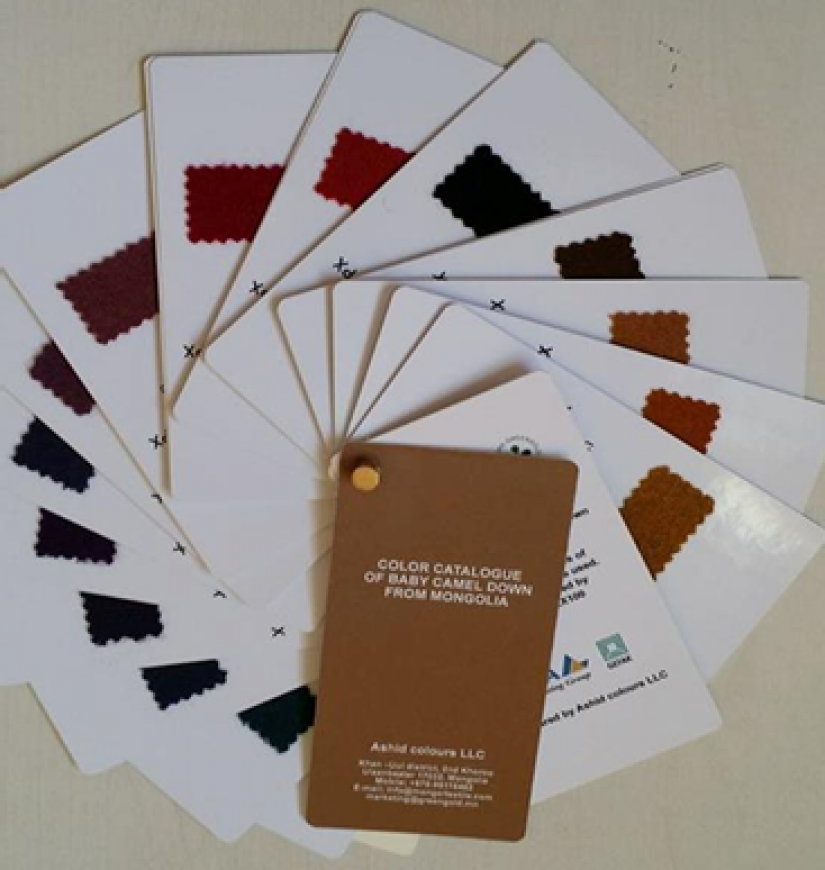

There are also other challenges observed in processing camel wool. For example, compared to cashmere, the cost of processing camel wool is much higher, whilst the yield is much less. For example, the yield of cashmere after the scouring and de-hairing processes is around 55%, whereas the yield of camel wool after these processes is only 33-34%. Furthermore, because camels live in the Gobi region, where the saline level is high, and also because the animal likes to roll in ash, the camel’s sweat is high in alkaline content. These minerals and elements are difficult to completely remove from the fibre during the scouring process, making the factory processes far more difficult, and leading to damage to the gears, cogs, and wheels of production machines. All domestic processors face this common problem, as they apply similar techniques when processing cashmere and camel wool. As a specific technique suitable for scouring camel wool was required, researchers such as G. Nadmid, state honoured scientist and dean of the Wool and Cashmere Department of the Research and Development Institute of Light Industry; B. Battsengel, professor of chemistry at the German-Mongolian Institute for Resources and Technology; G. Yondonsambuu, vice president of the Mongolian Wool and Cashmere Association; and V. Bolormaa, a textile specialist at the Ministry of Food, Agriculture and Light Industry, developed a new technique for scouring camel wool and tested the method by putting it into practice.
About the importance of producing organic products, G. Yondonsambuu said: “Camels with two humps are an endangered species living in Mongolia in large numbers. This means that our country has the main responsibility for increasing the size of herds. Compared to the goat, which eats the roots of the grass, thereby leading to desertification, the camel is an eco-friendly animal. The camel causes no damage to the environment and, moreover, does not compete with other types of livestock in consuming grass on the pasture. It also resists harsh winters. Furthermore, businesses all over the world are in the search of a fibre that can substitute for cashmere. Baby camel wool could be the best substitute for cashmere. However, the size of camel herds is not increasing that much. Our main goal should be to increase the number of camels and bring the quality of camel wool up to the quality of cashmere. The size of camel herds will increase only when the value of camel wool increases.”
Baby camel wool will open up new opportunities for increasing the value of camel herds, which are adaptive to an environment where there is increased pasture degradation, limited water resources, and limited types of plants, mainly shrubs. In addition, baby camel wool products can be appealing to the ”aspirational” consumers in the Western world, who look beyond the quality and design of their purchases. For the type of consumer who seeks out information about their purchases, such as their origin, materials, transparency, eco-friendliness, and other properties, a Bactrian camel wool product presenting unique but convincing stories as part of its package might be ideal. The Green Gold Project will ensure the delivery of such products as a new market trend within the next four years through innovative, creative, and technology-driven solutions.
 Ulaanbaatar
Ulaanbaatar















